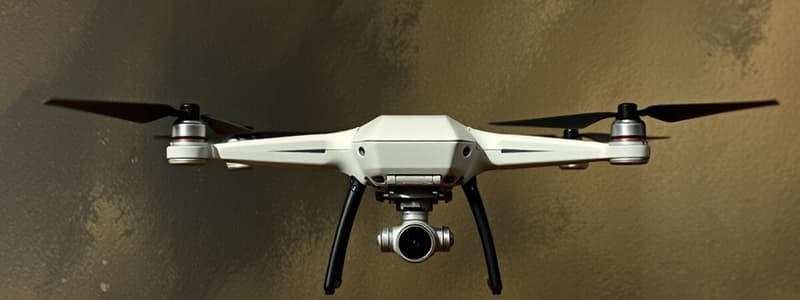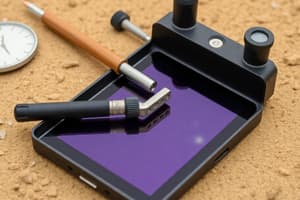Podcast
Questions and Answers
What technology is being used to sort ancient pottery designs effectively?
What technology is being used to sort ancient pottery designs effectively?
- Database management systems
- Convolutional Neural Networks (CNNs) (correct)
- 3D modeling software
- Augmented reality tools
What is the main benefit of using drones in archaeological research today?
What is the main benefit of using drones in archaeological research today?
- They solely function in documenting findings.
- They help in discovering ancient sites with minimal disturbance. (correct)
- They can create 3D models from pottery.
- They replace the need for traditional excavation methods.
What process is used to create digital 3D models during excavation?
What process is used to create digital 3D models during excavation?
- Digital mapping with GPS
- Virtual reality simulation
- Manual sketching and photos
- Structure-from-motion (SfM) photogrammetry (correct)
How did the computer used for pottery sorting compare with human archaeologists?
How did the computer used for pottery sorting compare with human archaeologists?
What was the role of Allison Emmerson in the Pompeii I.14 project?
What was the role of Allison Emmerson in the Pompeii I.14 project?
Which archaeological technique is described as emulating the human thought process in visual information analysis?
Which archaeological technique is described as emulating the human thought process in visual information analysis?
What is NOT a benefit of using technology in archaeology mentioned in the content?
What is NOT a benefit of using technology in archaeology mentioned in the content?
What aspect of archaeology does Dr. Alex Elvis Badillo emphasize in his work?
What aspect of archaeology does Dr. Alex Elvis Badillo emphasize in his work?
What is the primary objective of the Girsu Project's discovery?
What is the primary objective of the Girsu Project's discovery?
Which of the following is a common challenge that the CNN technology addresses in pottery sorting?
Which of the following is a common challenge that the CNN technology addresses in pottery sorting?
What kind of technology has been used to document excavations in the Pompeii I.14 project?
What kind of technology has been used to document excavations in the Pompeii I.14 project?
What was a significant achievement of the computerized method developed at Northern Arizona University?
What was a significant achievement of the computerized method developed at Northern Arizona University?
Which aspect of archaeology was specifically discussed in relation to the Girsu Project's discovery?
Which aspect of archaeology was specifically discussed in relation to the Girsu Project's discovery?
In archaeology, what purpose does using drones serve?
In archaeology, what purpose does using drones serve?
What innovation did Dr. Alex Elvis Badillo integrate into archaeological practices?
What innovation did Dr. Alex Elvis Badillo integrate into archaeological practices?
How does machine learning enhance the sorting of ancient pottery?
How does machine learning enhance the sorting of ancient pottery?
Which of the following describes a limitation previously faced by archaeologists that technology helps overcome?
Which of the following describes a limitation previously faced by archaeologists that technology helps overcome?
What advantage does the use of 3D documentation give during archaeological excavations?
What advantage does the use of 3D documentation give during archaeological excavations?
In the context of recent advances in archaeology, what does AI primarily assist with?
In the context of recent advances in archaeology, what does AI primarily assist with?
What is a key benefit of the Digital Data Initiatives team led by Allison Emmerson?
What is a key benefit of the Digital Data Initiatives team led by Allison Emmerson?
What unique capability does the CNN technology provide in the context of sorting pottery?
What unique capability does the CNN technology provide in the context of sorting pottery?
Which of the following best exemplifies the application of structure-from-motion (SfM) photogrammetry?
Which of the following best exemplifies the application of structure-from-motion (SfM) photogrammetry?
What is a primary goal of using advanced technology in archaeology as discussed in the content?
What is a primary goal of using advanced technology in archaeology as discussed in the content?
Which aspect of the Girsu Project highlights technological advancements in archaeology?
Which aspect of the Girsu Project highlights technological advancements in archaeology?
How does the NAU team's technology for pottery sorting compare to traditional methods?
How does the NAU team's technology for pottery sorting compare to traditional methods?
What challenge is addressed by the Digital Data Initiatives team in archaeological projects?
What challenge is addressed by the Digital Data Initiatives team in archaeological projects?
What comparative advantage do drones provide in archaeological exploration?
What comparative advantage do drones provide in archaeological exploration?
Which of the following reflects a misconception about the role of AI in archaeology?
Which of the following reflects a misconception about the role of AI in archaeology?
What process does the NAU technology utilize to sort pottery designs?
What process does the NAU technology utilize to sort pottery designs?
What is a potential drawback of using digital methods in archaeological documentation?
What is a potential drawback of using digital methods in archaeological documentation?
Flashcards are hidden until you start studying
Study Notes
Archaeological Technology Advancements
-
Drones are revolutionizing archaeological fieldwork, enabling a less invasive approach to excavation and site surveying. The Girsu project's discovery of an ancient palace exemplifies this.
-
AI and machine learning, specifically Convolutional Neural Networks (CNNs), are being used to analyze and categorize large datasets of archaeological artifacts, such as pottery shards. At Northern Arizona University, a CNN system outperformed some human experts in classifying pottery styles and provided explanations for its classifications.
-
Digital documentation workflows, using devices like iPads and structure-from-motion (SfM) photogrammetry, are creating detailed 3D models of excavation sites. This method at Pompeii's I.14 project preserves findings and enables more precise analysis. The 3D models are measurable, scaled and photorealistic for comprehensive record keeping.
Applications of Technology in Archaeology
-
Using drones in archaeology allows for aerial surveys of large sites, reducing ground disturbance and revealing hidden features.
-
AI-powered analysis of artifacts helps expedite sorting and classification, improving efficiency and enabling more detailed analysis.
-
3D modeling through photogrammetry enables detailed and accurate recording of excavation sites, allowing for virtual study and reconstruction in addition to traditional methods. This approach improves accessibility and preservation of data.
Archaeological Technology Advancements
-
Drones are revolutionizing archaeological fieldwork, enabling less invasive exploration. The Girsu Project's palace discovery exemplifies this.
-
AI-powered systems are improving the analysis of artifacts. A Convolutional Neural Network (CNN) at Northern Arizona University successfully categorized pottery shards, matching or exceeding the performance of experienced archaeologists. The system's ability to explain its classifications is a significant advancement.
Digital Archaeology in Practice
-
The Pompeii I.14 project utilized a paperless, 3D documentation workflow involving iPads and structure-from-motion (SfM) photogrammetry.
-
SfM photogrammetry created accurate, measurable, photorealistic 3D models of excavations, effectively acting as digital twins of sites. This technology facilitates detailed data collection and analysis.
Archaeological Technology Advancements
-
Drones are revolutionizing archaeological fieldwork, minimizing environmental impact and enabling wider survey areas. The Girsu Project's palace discovery exemplifies this.
-
AI-powered systems are enhancing the analysis of artifacts. Northern Arizona University researchers trained a Convolutional Neural Network (CNN) to classify pottery shards with accuracy comparable to human experts. This system even provides explanations for its classifications, a task often challenging for human archaeologists.
-
3D modeling and photogrammetry are transforming data collection and preservation. The Pompeii I.14 project utilized structure-from-motion (SfM) photogrammetry to create measurable, photorealistic 3D models of excavation sites, acting as "digital twins" of the real-world excavations. This method aids in data collection and analysis.
-
Paperless documentation workflows are increasing efficiency and improving data organization in archaeological projects. The Pompeii I.14project implemented a paperless system using iPads, combining photos and scientific sketches for enhanced record-keeping.
Studying That Suits You
Use AI to generate personalized quizzes and flashcards to suit your learning preferences.




